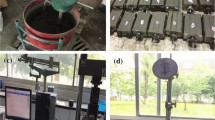Abstract
In construction industry large number of buildings are repaired and retrofitted due to the decrease in the load bearing capacity of RC beams within the life span of the building. Repair materials with reduced carbon footprint and environmental sustainability have been in great demand by the construction industry worldwide. Cement is the main constituent of the mortar used for the repair and retrofitting techniques. The production of cement is energy-intensive and releases large amount of carbon dioxide (CO2) to the atmosphere that significantly contributes to greenhouse gas emissions. It is estimated that one ton of CO2 is released into the atmosphere for every ton of ordinary Portland cement produced. Environmentally sustainable repair materials with reduced carbon footprint have been in great demand by the construction industry worldwide. Cement-free geopolymer mortars prepared from waste materials with high content of silicate aluminium and alkaline activator solution are emerging as prominent sustainable repair materials. Industrial waste Fly ash is used in this study as the replacement of cement. The current study focuses on strength comparison of cement mortar cubes and geopolymer mortar cubes in ambient curing conditions. 10M, 12M, 15M geopolymer mortar cubes are prepared for the study. Useage of geopolymer mortar leads to the reduction in cement quantity in construction industry and its use should be promoted for better performance and environmental sustainability.
Access this chapter
Tax calculation will be finalised at checkout
Purchases are for personal use only
Similar content being viewed by others
References
Ortega I et al (2018) An experimental study on RC columns repaired on all four sides with cementitious mortars. Constr Build Mater 161:53–62 (Science Direct)
Karuppuchamy K et al (2018) Effect of alkaline solution with varying mix proportion on geopolymer mortar. IOP Conf Ser Mater Sci Eng 310:1–9
Mahajan LS et al (2017) Experimental study of conventional and geopolymer mortar. Int J Sci 5(2):2277–7261
Author information
Authors and Affiliations
Corresponding author
Editor information
Editors and Affiliations
Rights and permissions
Copyright information
© 2020 Springer Nature Switzerland AG
About this paper
Cite this paper
Revathy, V., Antherjanam, G. (2020). Strength Comparison of Cement Mortar and Geopolymer Mortar. In: Dasgupta, K., Sajith, A., Unni Kartha, G., Joseph, A., Kavitha, P., Praseeda, K. (eds) Proceedings of SECON'19. SECON 2019. Lecture Notes in Civil Engineering, vol 46. Springer, Cham. https://doi.org/10.1007/978-3-030-26365-2_17
Download citation
DOI: https://doi.org/10.1007/978-3-030-26365-2_17
Published:
Publisher Name: Springer, Cham
Print ISBN: 978-3-030-26364-5
Online ISBN: 978-3-030-26365-2
eBook Packages: EngineeringEngineering (R0)




